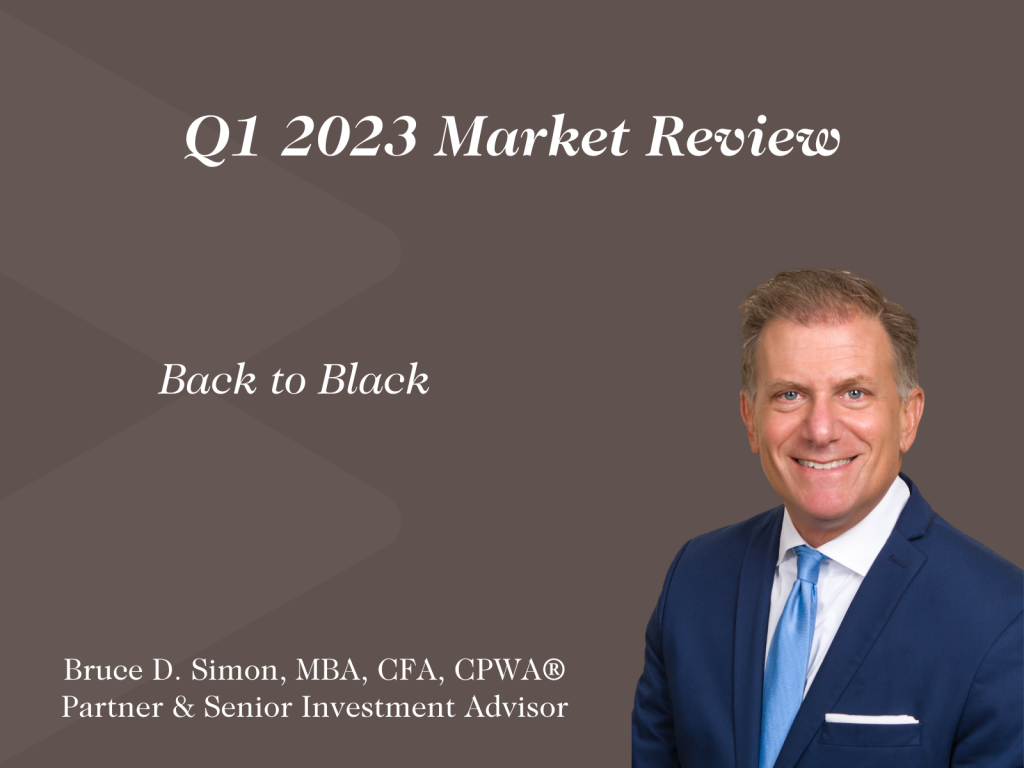Market Recap
Investors faced a litany of headwinds in the first quarter of 2023: rising interest rates, sticky inflation, war in Ukraine, banking crises, declining earnings, and doom-and-gloom Wall Street strategists, to name a few. Yet, as it often does, financial markets ignored conventional wisdom and posted solid gains in the quarter. The most likely explanations: the hope that the Fed would soon pause or even reverse their yearlong rate hiking cycle, and the resilience of the US and European economies relative to expectations.
The S&P 500 posted a solid gain of 7.5% in the first quarter, recovering a part of the painful 18.1% decline of 2022. Overseas, developed international stocks (as represented by the MSCI EAFE Index) rose 8.5%, paced by the European equity market’s gain of 10.6%. Europe’s ability to successfully navigate around its reliance on energy supplies from Russia (helped by an exceptionally mild winter) certainly contributed to the region’s strong relative performance. Despite the lifting of the harsh lockdown rules in China late last year, Chinese equities (and by extension, emerging markets equities as a whole) failed to keep pace with the rest of the world. The MSCI Emerging Markets Index rose 4.0% in the quarter.
A disappointing inflation report in early February sent interest rates upward as investors recalibrated higher their expectation for the high point in this cycle. Then the collapse of Silicon Valley Bank in March ignited concerns of a banking industry crisis, causing rates to fall sharply. The decline in rates pushed bond prices higher, leading to solid gains in fixed income securities across the yield curve. After two years of negative returns for the broad US bond market (as measured by the Bloomberg US Aggregate Bond Index), bonds posted their best quarterly return since the second quarter of 2020. The falling rate environment also rekindled investor appetite for the large capitalization growth stocks (e.g., Amazon, Apple, Meta) that badly lagged their value counterparts in 2022.
Outlook and Strategy
Investors are anxiously awaiting signs of a Fed “pivot”, when the Fed’s inflation-fighting monetary policy is relaxed in favor of a focus on avoiding a serious recession. While the Fed’s forward guidance for more rate hikes has softened a bit in light of the recent turmoil in the banking industry, in our view the market’s expectation for significant rate cuts beginning later in 2023 seems overly optimistic unless economic conditions take a serious turn for the worse. The Fed continues to emphasize the need for inflation to recede further in order to justify a change in strategy.
The job of calibrating just how much monetary tightening is necessary to break the back of inflation is complicated by the long lead time necessary for their efforts to work their way through certain parts of the economy. It became immediately apparent in sectors such as real estate (as a surge in mortgage rates cooled housing demand) but in other areas the impact has yet to be felt as job growth remains strong. Further complicating the Fed’s job is the pressure that higher rates are putting on the banking industry, faced with unrealized losses on their securities holdings and deposits fleeing to higher-yielding money market funds. Fed Chair Powell’s job is a difficult and thankless one.
While Fed policy isn’t the only factor driving asset prices, it does represent an early window into the shape of economic activity in the future. And while the next quarter or two will provide additional clues into the extent of the current slowdown in the global economy, it seems likely that sometime in 2024 we should see a recovery in economic growth and a more accommodative Fed. Stock prices usually anticipate a recovery several quarters beforehand, so we expect patient investors to be rewarded for sticking through the current period of uncertainty.
Could stocks take a sharp tumble in the interim? Certainly. If the previous rounds of Fed tightening cause the current banking turmoil to spread (which will inhibit credit expansion) and trigger a more serious recession than we expect, stocks could be in for a rough ride. Our advice is to ignore those strategists who seem so clear-eyed about the short run but are never called to task for the accuracy of their past predictions.
One thing is certain: fixed income is far more attractive than it was a year ago and now represents legitimate competition to the stock market for investor dollars. Having been underweight for several years, we are now re-evaluating our current fixed income positioning with an eye toward exploiting opportunities such as long-dated municipal bonds which are generating attractive taxable-equivalent yields.
For those with short-term cash needs, 6-month treasury bills yielding 4.75% are extremely attractive. For longer term investors, however, it is important to remember that short-term instruments have almost never exceeded the return of stocks over a multi-year timeframe. For that reason, we encourage investors to stick with their long-term plan and avoid over-reliance on the fleeting nature of high-yielding cash equivalents. While enticing, a recovery in stock prices is likely to leave cash in the dust.
About Bruce D. Simon, MBA, CFA, CPWA®
Bruce is a Partner & Senior Investment Advisor at the firm. In addition to working directly with a number of family clients, Bruce serves on Ballentine’s Investment Management Committee, which is responsible for the oversight of all of the investment activities for the firm.
This report is the confidential work product of Ballentine Partners. Unauthorized distribution of this material is strictly prohibited. The information in this report is deemed to be reliable. Some of the conclusions in this report are intended to be generalizations. The specific circumstances of an individual’s situation may require advice that is different from that reflected in this report. Furthermore, the advice reflected in this report is based on our opinion, and our opinion may change as new information becomes available. Nothing in this presentation should be construed as an offer to sell or a solicitation of an offer to buy any securities. You should read the prospectus or offering memo before making any investment. You are solely responsible for any decision to invest in a private offering. The investment recommendations contained in this document may not prove to be profitable, and the actual performance of any investment may not be as favorable as the expectations that are expressed in this document. There is no guarantee that the past performance of any investment will continue in the future.




